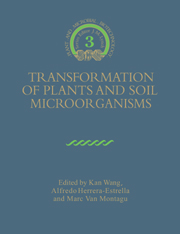Book contents
- Frontmatter
- Contents
- List of Contributors
- Series Preface
- Preface
- Acknowledgements
- Abbreviations and Terms
- Part I Transformation of Soil Microorganisms
- 1 Pseudomonas
- 2 Nocardioform and Coryneform Bacteria
- 3 Agrobacterium, Rhizobium, and Other Gram-Negative Soil Bacteria
- 4 Filamentous Fungi
- Part II Transformation of Cereal Crops
- Part III Transformation of Industrially Important Crops
- Index
4 - Filamentous Fungi
Published online by Cambridge University Press: 04 August 2010
- Frontmatter
- Contents
- List of Contributors
- Series Preface
- Preface
- Acknowledgements
- Abbreviations and Terms
- Part I Transformation of Soil Microorganisms
- 1 Pseudomonas
- 2 Nocardioform and Coryneform Bacteria
- 3 Agrobacterium, Rhizobium, and Other Gram-Negative Soil Bacteria
- 4 Filamentous Fungi
- Part II Transformation of Cereal Crops
- Part III Transformation of Industrially Important Crops
- Index
Summary
Introduction
Fungi are eukaryotic, heterotrophic organisms with an absorptive mode of nutrition. Most fungi are both unicellular and multinucleate, with rigid chitinous cell walls, and usually exhibit mycelial or yeast-like growth habit. Probably most of the biotechnologically important soil fungi have no stable recombination cycles in the laboratory. This creates problems for physiological and genetic studies in these species. Genetic manipulation using transformation and gene cloning provides the most logically directed approach to dissect and, eventually, alter the physiology of these filamentous fungi. Towards this end, there has been strong pressure to develop techniques of basic molecular biology suitable for these organisms. The most intensively studied fungi are the unicellular yeast Saccharomyces cerevisiae and the filamentous fungi Neurospora crassa and Aspergillus nidulans. The molecular genetic systems of these organisms have served as the basis for development of similar systems in less tractable but economically important fungal species (Timberlake & Marshall, 1989).
The first report of transformation of a fungal species mediated by DNA was published by Mishra & Tatum (1973). Growing cultures of an inositol-requiring mutant of N. crassa were transformed with total DNA of the wild-type together with calcium; from the conidia formed on such cultures it was possible to select prototrophic strains. This pioneering experiment was received with skepticism and only some years later, Hinnen, Hicks & Fink (1978) reported transformation of S. cerevisiae using protoplasts from a Ieu2 mutant by treatment with wild-type DNA in the presence of calcium chloride.
- Type
- Chapter
- Information
- Transformation of Plants and Soil Microorganisms , pp. 34 - 50Publisher: Cambridge University PressPrint publication year: 1995
- 1
- Cited by

